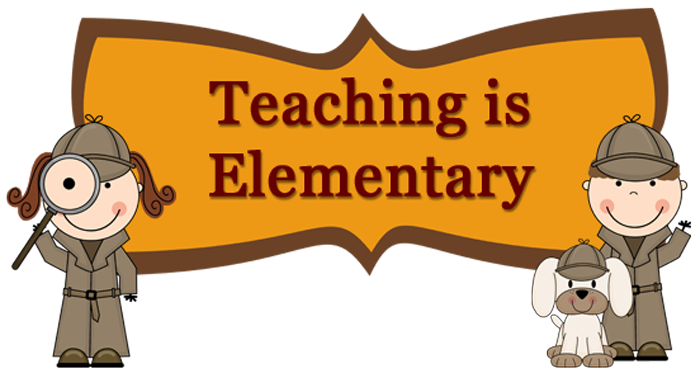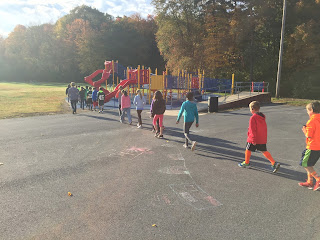Twenty years ago "Active Shooter Training" would not have been a topic for a school's in-service day for teachers. Unfortunately, with so many shootings happening in a school setting it was inevitable that it take place. According to
StopTheShootings.Org since 1992 there have been 387 recorded shootings in schools across the United States.
It's good to have a plan and practice it in the event of an emergency.
We prepare our students for Fire Drills and Lockdown Drills
(and depending where you live Earthquake or Tornado Drills). Currently, our lockdown drills consist of locking our classroom doors, shutting off the lights and huddling in a corner while keeping our students quiet and calm.
However, yesterday our district went to the 'next level' of preparedness and had all elementary school personnel participate in a "realistic" training provided by
SynergySolutions, which is comprised of trained instructors from law enforcement, military and federal agencies. (Please note - NO STUDENTS were in the building or took part in this training. It was strictly school personnel.)
 |
| Our Classroom Trainer |
This proactive approach shared by Synergy Solutions Co-Founder, Sgt. Jason Brennan, includes the philosophy of "Lockdown! Leave! Live!" which encourages folks to "Locate the problem then make a decision on how to react." Sgt. Brennan stated that law enforcement officers and first responders have already been trained how to handle these types of situations. But he feels the teachers are the "missing link" in the training process. These are the folks who will be in the situation before help arrives.
Below are just some of the notes I took.
- Lockdown includes some of these ideas:
- draw the shades
- turn of lights
- barricade doors with furniture
- rope tie the door
- Leave based on 'real time' information
- avoid hallways
- auditoriums
- cafeterias
- find another space
- if outside - zig zag pattern to find cover
- Live not fight but attack if necessary using nearby items
- fire extinguishers
- laptop
- chairs
- keys
- books
- purse
Part of this training included participating in a REALISTIC event. We were each assigned to a classroom where we received further instruction by one of the highly trained members of Synergy Solutions. Looking around the room he pointed out different ways to "lockdown" the room.
LOCKDOWN: We knew ahead of time there would be gunfire (blanks) which would simulate what it might sound like if a shooter were in the building.
Pop! Bang! The sound of gunfire was apparent in the hallway. Knowing it was going to happen didn't make it any less scary either!
 |
| Barricade at the Back Door |
Quickly we all reacted by grabbing desks and chairs and piling them up near the doors, jamming door stoppers under the doors, pulling shades, shutting lights, etc. Although we knew it was a drill the adrenaline was still pumping through our veins as we worked together to achieve the goal of securing the room. Waiting silently in the dark against the wall for the all clear made it seem real.
LEAVE: Next, we were all asked to go into the hallway. Again, instruction was given as to what precautions/reactions we should take. Pretty soon shots rang out and people scrambled into a nearby classroom. Soon the the task of obstructing doorways commenced.
Second time around we worked more rapidly than before as we understood what to do...practice makes perfect! (or close to it!)
LIVE: Finally, we were all together in the open auditorium. Jay explained what would happen next and gave us some precautions. Again knowing there would be shots didn't take away the surprise and panic. When confronted with the ear-piercing sound people immediately started scattering for any one of the exits. The goal: leave and live!
I ended up perched precariously on a bench behind a curtain in the girls locker room! Not the safest place for sure! Other colleagues had locked themselves in the bathroom and used their pursed to secure the door handles even further. Others ran from room to room trying to gain access only to find locked doors.
Time s l o w e d as we waited for the time to report back to the auditorium (which was only about 5 minutes!) All the while, knowing in a real situation we might be waiting for hours. Certainly an eye opener for all.
Realistic trainings like this have their pros and cons. Initially, I wasn't keen on the idea because, if truth be told I can't be sure how I would react in this kind of a stressful situation. Having a plan, being walked through it, makes me a little more comfortable. Would I in a real situation grapple with desks and chairs to barricade a door? Would I instruct my students to leave the building and run in a zig zag pattern to a pre-determined meeting place?
Knowing I'm responsible for 20+ students makes me take this seriously and think about an event too unfathomable to comprehend. All I know is I'd go to the ends of the earth and back to make sure my students were safe - even if it means training in a school with the sounds of gunfire blanks.
Resources:
Local Article about SynergySolutions
ALICE Training Institute - How to Respond to an Active Shooter Event
Department of Homeland Security - Active Shooter Preparedness
School Lockdown Calculus: The Line Between Preparedness & Trauma-by Dr. Steven Schlozman
What are your ideas about REALISTIC training scenarios such as this?
































